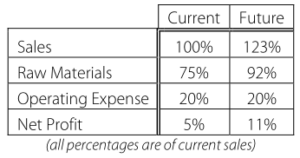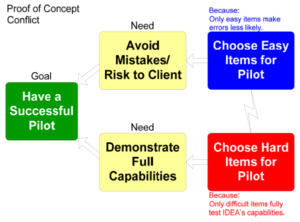Implementing a whole new way to approach logistics and inventory management can be a daunting task. Since, prospective clients can’t anticipate all the implications of transitioning their supply chain from Push to Pull before taking the plunge, we first suggest a test on a small scale. A Proof of Concept reduces risk by limiting exposure and gaining Client buy-in. This paper answers the title question and several others, such as:
- What sales, profit and cash benefits are reasonable to expect from a full implementation?
- How do I choose the right subset of our products for the Proof of Concept?
- How long should the test last?
Measuring Sales Improvements
Our replenishment solution, Elucidate, was developed from Dr. Eliyahu Goldratt’s Theory of Constraints (TOC). One reason to begin with a Proof of Concept is to identify the magnitude of sales increases that can reasonably be expected from implementing Elucidate. We use the standard guide: sales increases are normally an order of magnitude larger than measured shortages. For example, if you measure shortages at 3% currently, Elucidate typically unearths 30% more sales.
After managing a group of SKUs with Elucidate for a reasonable amount of time, we simply look at the change in those products compared to the rest of the items (the control group) that continue to be managed conventionally.
Assume Elucidate items grow an average of 19% while the rest of the products sold 4% less. Since the only difference is the TOC replenishment solution, we conclude that it produces about 23% more sales than the conventional way.
The following chart shows the value to a distributor whose cost is 75% of sales. We assume no additional people are needed to sell what is in stock, instead of scrambling for a substitute. Ignoring the other 8 profit drivers, availability alone suggests net profits can be more than doubled.

Similarly, if the products in question are raw materials, we measure availability rates. How much of the time are Proof of Concept products available to the next stage of the manufacturing process compared to the rest of the raw materials? A second measurement is the length of time the outage lasts for both groups of products. Remember, the cost of production downtime due to the lack of availability is huge. If even part of a plant stops producing, it may cause loss of sales to the whole system until the raw material supply is again restored.
Either way, as life gets easier for people because items covered by the Proof of Concept stay in stock, we can predict the impact under a full implementation. Knowing what to expect allows us to reasonably anticipate the benefits Elucidate brings to a client.
Which Products to Include in the Proof of Concept
The choice of which products to include is an interesting one. We want a successful Proof of Concept. In order to achieve that goal, we must ensure mistakes are minimized. To make sure there are few mistakes, we must choose products that are easy to implement, because if the products are easy, only then are mistakes less likely. We also need to show IDEA’s system can handle all the challenges it will experience during the full implementation. To meet that need, we must choose products that are hard to implement, because we won’t have proven much unless we tackle tough issues. Oops, we have a conflict. The necessary actions are opposites. See the following diagram:

Shippers Solutions believes in the TOC principle of inherent simplicity. Given an agreed upon goal, there is no reason to accept any conflict’s existence. We shouldn’t allow conflicts to persist in our businesses. To break the conflict, we inject the following:
Our replenishment solution is so well tested and monitored that any item can be handled without mistakes. Therefore, even if we chose difficult items, risks to the client are far less than laboring under the intrinsic risks of continuing with their current approach. Before we get to the point of running a Proof of Concept, the client has agreed there are problems, issues and undesirable effects in their business. The Proof of Concept is the first tangible step toward improving the client’s world.
Now the gloves are off. We can and should choose difficult products. Even when we do so, we still meet both needs. However, so long as some of the products are tough enough to prove that our approach can handle anything, we should also choose easy and high volume ones. If either easy or hard products are omitted from the test group, perhaps not unreasonably, a client might argue that their product mix is too different from the test group to draw a correlation. The sample size should be large enough to ensure that an example of most of the universe of products is represented in the scope of the pilot.
Duration of the Proof of Concept
It is not essential that this effort wring every last benefit from the SKUs included. TOC’s five focusing steps and Pareto analysis are used as prioritization tools. They ensure that the most significant results are seen quickly. Six to eight average replenishment periods are enough to see where the Proof of Concept is going. Add to that three weeks of training, spread throughout the pilot to gain buy-in for the full implementation. So, if items are usually replenished from the plant or supplier in 10 days, three months would be a good test period. Add more time to be better persuaded, but remember, that time spent proving delays more broad based results. In any case, do not embark on the full implementation without clear results from the Proof of Concept.
Proof
The pilot has three purposes. First, prove to nay-sayers that Shippers Solutions replenishment solution works as a means to:
- increase sales/productivity
- improve response times to customers/plants with less inventory
- reduce operating expense
- be a robust long lasting, easy to live with solution
- reduce risks
- get quick results
Secondly, a proper Proof of Concept creates an agreed upon target for the full implementation. And, thirdly, it establishes a way to attribute results between the client’s efforts and Shippers Solutions, so the client always knows how much return there is on their investment in our services.
Written By: Henry F. Camp
Published by: Jake Lanning
